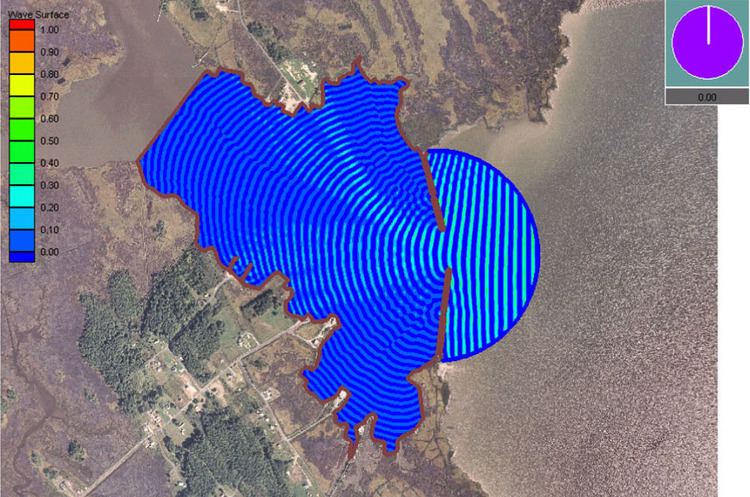 | ||
In fluid dynamics, the mild-slope equation describes the combined effects of diffraction and refraction for water waves propagating over bathymetry and due to lateral boundaries—like breakwaters and coastlines. It is an approximate model, deriving its name from being originally developed for wave propagation over mild slopes of the sea floor. The mild-slope equation is often used in coastal engineering to compute the wave-field changes near harbours and coasts.
Contents
- Formulation for monochromatic wave motion
- Transformation to an inhomogeneous Helmholtz equation
- Propagating waves
- Derivation of the mild slope equation
- Monochromatic waves
- Applicability and validity of the mild slope equation
- References
The mild-slope equation models the propagation and transformation of water waves, as they travel through waters of varying depth and interact with lateral boundaries such as cliffs, beaches, seawalls and breakwaters. As a result, it describes the variations in wave amplitude, or equivalently wave height. From the wave amplitude, the amplitude of the flow velocity oscillations underneath the water surface can also be computed. These quantities—wave amplitude and flow-velocity amplitude—may subsequently be used to determine the wave effects on coastal and offshore structures, ships and other floating objects, sediment transport and resulting geomorphology changes of the sea bed and coastline, mean flow fields and mass transfer of dissolved and floating materials. Most often, the mild-slope equation is solved by computer using methods from numerical analysis.
A first form of the mild-slope equation was developed by Eckart in 1952, and an improved version—the mild-slope equation in its classical formulation—has been derived independently by Juri Berkhoff in 1972. Thereafter, many modified and extended forms have been proposed, to include the effects of, for instance: wave–current interaction, wave nonlinearity, steeper sea-bed slopes, bed friction and wave breaking. Also parabolic approximations to the mild-slope equation are often used, in order to reduce the computational cost.
In case of a constant depth, the mild-slope equation reduces to the Helmholtz equation for wave diffraction.
Formulation for monochromatic wave motion
For monochromatic waves according to linear theory—with the free surface elevation given as
where:
The phase and group speed depend on the dispersion relation, and are derived from Airy wave theory as:
where
For a given angular frequency
Transformation to an inhomogeneous Helmholtz equation
Through the transformation
the mild slope equation can be cast in the form of an inhomogeneous Helmholtz equation:
where
Propagating waves
In spatially coherent fields of propagating waves, it is useful to split the complex amplitude
where
This transforms the mild-slope equation in the following set of equations (apart from locations for which
where
The last equation shows that wave energy is conserved in the mild-slope equation, and that the wave energy
The first equation states that the effective wavenumber
Derivation of the mild-slope equation
The mild-slope equation can be derived by the use of several methods. Here, we will use a variational approach. The fluid is assumed to be inviscid and incompressible, and the flow is assumed to be irrotational. These assumptions are valid ones for surface gravity waves, since the effects of vorticity and viscosity are only significant in the Stokes boundary layers (for the oscillatory part of the flow). Because the flow is irrotational, the wave motion can be described using potential flow theory.
The following time-dependent equations give the evolution of the free-surface elevation
From the two evolution equations, one of the variables
and the corresponding equation for the free-surface potential is identical, with
Monochromatic waves
Consider monochromatic waves with complex amplitude
with
Applicability and validity of the mild-slope equation
The standard mild slope equation, without extra terms for bed slope and bed curvature, provides accurate results for the wave field over bed slopes ranging from 0 to about 1/3. However, some subtle aspects, like the amplitude of reflected waves, can be completely wrong, even for slopes going to zero. This mathematical curiosity has little practical importance in general since this reflection becomes vanishingly small for small bottom slopes.
